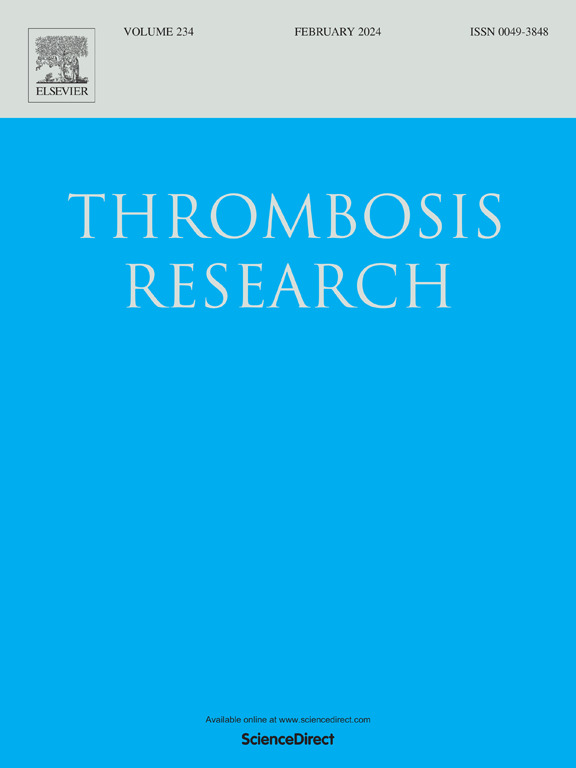法国肺栓塞的季节性和地域梯度:一项8年全国回顾性分析。
IF 3.4
3区 医学
Q1 HEMATOLOGY
引用次数: 0
摘要
引言:肺栓塞(PE)的季节性越来越多地被描述,表明寒冷的气象条件的负面影响。然而,对地理和气候影响知之甚少。由于气候多样,区域温度范围大,法国为强调与气候相关的PE患病率差异提供了一个模型。因此,我们使用标准化的性别和年龄层,对全国每个季节和地理区域的PE患病率进行了8年的回顾性分析。方法:法国医院出院数据库提供医院管理的PE数据,包括性别、年龄和地理编码,以计算PE的标准化患病率(PE- sp)并绘制其地理分布图。气候条件是根据区域平均温度估计的。结果:2012年至2019年,我们共发现341,365例PE(中位年龄71岁,女性53.04%)。PE-SP具有恒定的季节性,在最冷的月份发病率较高(全球+ 28.4%),2月为高峰,6月为低谷(每10万居民分别为0.272例和0.218例)。PE-SP也表现出明显的地域梯度,从西到东、从南到北逐渐增大,中位震级为86.9%,(IQR为73.3% ~ 98.4%,极值为50.1% ~ 133%)。无论性别、年龄、季节和年份,这种梯度都是不变的。最后,根据气候条件表达PE-SP的线性回归分析发现,PE-SP与TXQ10(日温度的第10百分位数)显著相关,表明PE-SP在传统上暴露于较冷天气的地理区域较高。结论:在法国,PE的发生具有不同季节和不同地域的异质性。在考虑血栓形成风险时,应考虑患者的地理(季节和地域)生物群落。本文章由计算机程序翻译,如有差异,请以英文原文为准。
Seasonality and territorial gradient of pulmonary embolism in France: an 8-year retrospective nationwide analysis
Introduction
Seasonality of Pulmonary Embolism (PE) is increasingly described, suggesting the negative impact of cold meteorological conditions. Yet, little is known about geographical and climatic impact. With various climates, and large regional temperature ranges, France provides a model for highlighting climate-related differences in PE prevalence. We thus made a whole country, 8-year retrospective analysis of PE prevalence, per season and geographical area, using standardized sex and age strata.
Methods
The French Hospital Discharge Database provided data on in-hospital-managed PE, with sex, age and geographical codes to calculate the standardized prevalence of PE (PE-SP) and map its geographical distribution. Climatic conditions were estimated taking average regional temperatures. Results: From 2012 to 2019, we identified 341,365 cases of PE (median age, 71y; 53.04 % female). PE-SP shows constant seasonality, with a higher incidence during the coldest months (globally +28.4 %), a peak in February and a trough in June (0.272 and 0.218 cases per 100,000 inhabitants respectively).
PE-SP also exhibits a marked territorial gradient, increasing from West to East and South to North, with a median magnitude of 86.9 %, (IQR 73.3 %–98.4 %, extreme values 50.1 %–133 %). This gradient remains whatever the sex or age, and over seasons and years. Finally, linear regression analysis, expressing PE-SP according to climatic conditions, found a significant association with TXQ10 (10th percentile of daily temperatures), highlighting higher PE-SP in geographical areas traditionally exposed to colder weather.
Conclusions
In France, PE occurrence is heterogeneously distributed, over seasons and also over territories. Geographical (seasonal and territorial) patient biotope should be considered regarding the thrombotic risk.
求助全文
通过发布文献求助,成功后即可免费获取论文全文。
去求助
来源期刊

Thrombosis research
医学-外周血管病
CiteScore
14.60
自引率
4.00%
发文量
364
审稿时长
31 days
期刊介绍:
Thrombosis Research is an international journal dedicated to the swift dissemination of new information on thrombosis, hemostasis, and vascular biology, aimed at advancing both science and clinical care. The journal publishes peer-reviewed original research, reviews, editorials, opinions, and critiques, covering both basic and clinical studies. Priority is given to research that promises novel approaches in the diagnosis, therapy, prognosis, and prevention of thrombotic and hemorrhagic diseases.
 求助内容:
求助内容: 应助结果提醒方式:
应助结果提醒方式:


